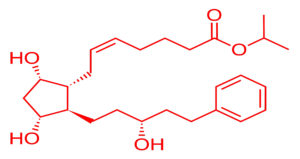
When it comes to manufacturing and sourcing Latanoprost API, ensuring GMP Latanoprost quality is critical for ophthalmic drug success. As a temperature- and light-sensitive compound used in sterile eye drops, Latanoprost must be produced, tested, and handled under globally accepted quality systems. At the center of this assurance is GMP certification—a mandatory standard that guarantees consistency, safety, and regulatory compliance.
In this blog, we explore what GMP (Good Manufacturing Practice) means for Latanoprost API, why it’s critical for your formulations, and how a GMP-certified supplier like Chemignition Laboratory ensures consistent, safe, and regulatory-approved production.
1. What Is GMP Certification in API Manufacturing?
GMP (Good Manufacturing Practice) is a globally recognized quality standard enforced by regulatory agencies such as:
- WHO (World Health Organization)
- US FDA (Food and Drug Administration)
- EMA (European Medicines Agency)
- PIC/S (Pharmaceutical Inspection Co-operation Scheme)
It ensures that APIs are consistently produced and controlled according to quality standards appropriate for their intended use.
In GMP Latanoprost quality manufacturing, GMP governs:
- Cleanroom environments
- Raw material sourcing
- Equipment calibration
- In-process controls
- Final batch testing
- Traceability and batch records
- Qualified personnel and SOPs
2. Why Is GMP Certification Critical for GMP Latanoprost Quality?
Latanoprost is used in sterile ophthalmic products, where contamination, impurities, or instability can directly affect eye health and product approval.
GMP helps prevent:
- Cross-contamination in cleanrooms
- Degradation due to improper storage or packaging
- Inconsistent assay values in different batches
- Regulatory rejection due to missing data or audit issues
✅ Without GMP certification, GMP Latanoprost quality cannot be assured, especially in regulated markets like the US, EU, UK, Canada, or Japan.
3. Key GMP Practices That Ensure Latanoprost API Quality
✅ 1. Validated Manufacturing Process
Each batch of Latanoprost is produced under a validated, reproducible process—ensuring GMP Latanoprost quality and consistency.
✅ 2. Controlled Environment
Cleanrooms are maintained under ISO 7 or ISO 8 standards, with HEPA filtration, airlocks, and microbial monitoring.
✅ 3. Quality Control Testing
- In-process testing
- Final assay, impurity, and stability tests
- Elemental impurity analysis (ICH Q3D)
- Residual solvent analysis (ICH Q3C)
✅ 4. Training & Documentation
All personnel follow documented SOPs, undergo routine training, and operate under a quality management system (QMS).
4. GMP & Regulatory Documentation
GMP compliance plays a direct role in generating and maintaining essential documentation that confirms GMP Latanoprost quality, such as:
| Document | Use |
|---|---|
| CoA (Certificate of Analysis) | Confirms assay, impurities, and specifications |
| DMF (Drug Master File) | Required for US FDA submissions |
| ASMF (Active Substance Master File) | For EMA and EU market submissions |
| Stability Data | Justifies shelf life and retest period |
| Impurity Profile | Needed for dossier submission and patient safety assurance |
| GMP Certificate | Proof of compliance for regulatory authorities |
📅 Chemignition Laboratory includes all documentation to demonstrate GMP Latanoprost quality for each shipment.
5. GMP & Packaging Integrity
Latanoprost is sensitive to light, oxygen, and temperature. GMP-certified packaging ensures GMP Latanoprost quality by preventing degradation.
- Uses glass or PP vials for chemical stability
- Sealed in poly bags and aluminum foil pouches
- Placed in HDPE containers with gel packs
- Delivered via cold chain shipping (−20°C to −10°C)
GMP requires packaging validation, labeling accuracy, and proper storage SOPs to maintain the API’s 36-month shelf life.
6. GMP in Facility Audits & API Supplier Selection
When your product undergoes FDA or EMA audit, your Latanoprost API source is examined.
GMP-certified suppliers ensure:
- Facility audit reports
- Batch records
- CAPA documentation
- Equipment qualification
- Analytical method validations
📅 Choosing a GMP-certified partner ensures GMP Latanoprost quality from procurement to approval.
7. Global Acceptance of GMP Latanoprost Quality
| Country/Region | Accepted GMP Standard |
| USA | US FDA GMP or ICH Q7 equivalent |
| EU | EU-GMP or WHO-GMP |
| UK, Canada, Australia | PIC/S or mutual recognition agreements |
| Middle East & LATAM | WHO-GMP, some local audit needed |
WHO-GMP, as maintained by Chemignition Laboratory, is globally accepted for demonstrating GMP Latanoprost quality.
Why Choose Chemignition Laboratory for GMP Latanoprost Quality?
At Chemignition Laboratory, we uphold the highest GMP standards to ensure consistent, compliant, and safe Latanoprost API.
Our Strengths:
- GMP certified site
- CoA, MSDS, impurity profile with each batch
- Cold chain packaging and temperature tracking
- 36-month shelf life
- Regulatory and audit support
🔼 With GMP Latanoprost quality at our core, we help clients launch compliant, high-performing ophthalmic products.
Conclusion
GMP certification is essential for maintaining GMP Latanoprost quality, reducing risk, and ensuring regulatory success. For APIs used in sensitive formulations like eye drops, GMP ensures:
- Cleanroom consistency
- Assay and impurity control
- Reliable documentation
- Global audit readiness
Trust Chemignition Laboratory as your partner for GMP-compliant, high-purity, long-shelf-life Latanoprost API—delivered globally with documentation you can rely on.
📢 Ready to source GMP-grade Latanoprost API?
📩 Contact Chemignition Laboratory today for documentation, pricing, and DMF support.
FAQs
What does GMP certification mean for Latanoprost API quality?
GMP certification ensures that Latanoprost API is manufactured under strict quality systems, covering cleanroom controls, validated processes, impurity testing, documentation, and regulatory compliance. It guarantees consistency and safety, especially for ophthalmic formulations.
Why is GMP important specifically for Latanoprost API?
Latanoprost is used in sterile eye drops, so it must meet the highest quality and purity standards. GMP guidelines prevent contamination, ensure assay consistency, and reduce regulatory risks when submitting to agencies like the FDA or EMA.
Does GMP certification impact regulatory approval?
Yes. APIs without GMP certification are often rejected during audits or dossier review. Regulatory agencies require evidence of GMP to approve the use of Latanoprost in pharmaceutical products.
How does packaging relate to GMP Latanoprost quality?
GMP-certified packaging protects Latanoprost from degradation. It involves storing the API in PP/glass vials, sealing them in poly bags and aluminum foil, and transporting them with cold chain logistics to maintain potency and shelf life.
What documents confirm GMP Latanoprost quality?
Key documents include the GMP certificate, CoA (Certificate of Analysis), DMF (Drug Master File), ASMF (for EU), impurity profile, MSDS, and validated stability data.



